Landowners, we need your help...
CDFW has deployed nutria survey teams from Suisun Marsh, throughout the Delta, down the San Joaquin Valley and needs written access permissions to enter or cross private properties for the purposes of conducting nutria surveys and, where detected, implementing trapping efforts. Landowners and tenants, we need your help (PDF); so CDFW can survey for and remove destructive nutria from your properties, complete and submit the Nutria Project Temporary Entry Permit (PDF).
How to Report a Sighting
Suspected observations or potential signs of nutria should be photographed and immediately reported to CDFW's Invasive Species Program online, by email to Invasives@wildlife.ca.gov, or by phone at (866) 440-9530. Observations on state or federal lands should be immediately reported to local agency staff on the property. Reports will be followed up on by the interagency nutria response team and will help in their eradication effort. If possible, photos of animals should include views of the whiskers, front or hind foot, or tail; for optimal photos of tracks, include an object for size reference (e.g., pencil, quarter, wallet) and take the photo from the side, at an angle (≤ 45º) to cast shadows into the track.
Please consult the nutria identification flyer (PDF) or "Nutria Identification" section below for reference images and other commonly confused species. Additionally, the Delta Stewardship Council has developed a convenient nutria pocket guide (PDF) to aid in field identification of nutria; to request the printed pocket guide(s), please contact CDFW at Invasives@wildlife.ca.gov or (866) 440-9530.
General Information
For general information on nutria biology and ecology please see the nutria species profile page.
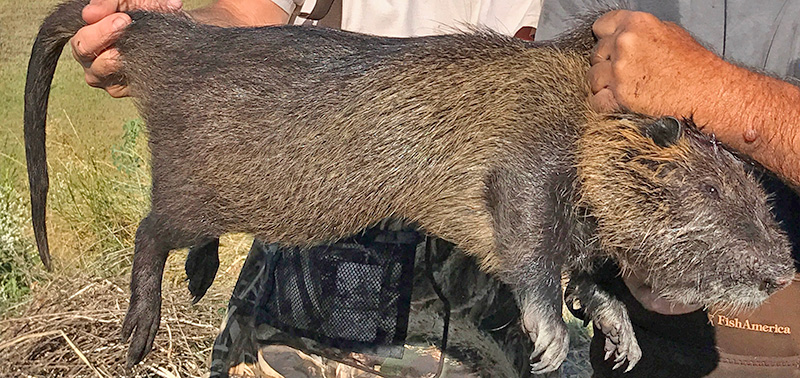 Large, male nutria trapped in a private wetland in Merced County, June 2017. CDFA photo.
Large, male nutria trapped in a private wetland in Merced County, June 2017. CDFA photo.
Nutria Impacts
Through their extensive herbivory and burrowing habits, nutria have devastating impacts on wetland habitats, agriculture, and water conveyance/flood protection infrastructure. Nutria consume up to 25% of their body weight in above- and below-ground plant material each day. Due to their feeding habits, up to 10 times the amount of plant material consumed is destroyed, causing extensive damage to the native plant community, soil structure, and nearby agricultural crops. The loss of plant cover and soil organic matter results in severe erosion of soils, in some cases converting marsh to open water. Further, nutria burrow into banks and levees, creating complex dens that span as far as 6 meters deep and 50 meters into the bank and often cause severe streambank erosion, increased sedimentation, levee failures, and roadbed collapses.
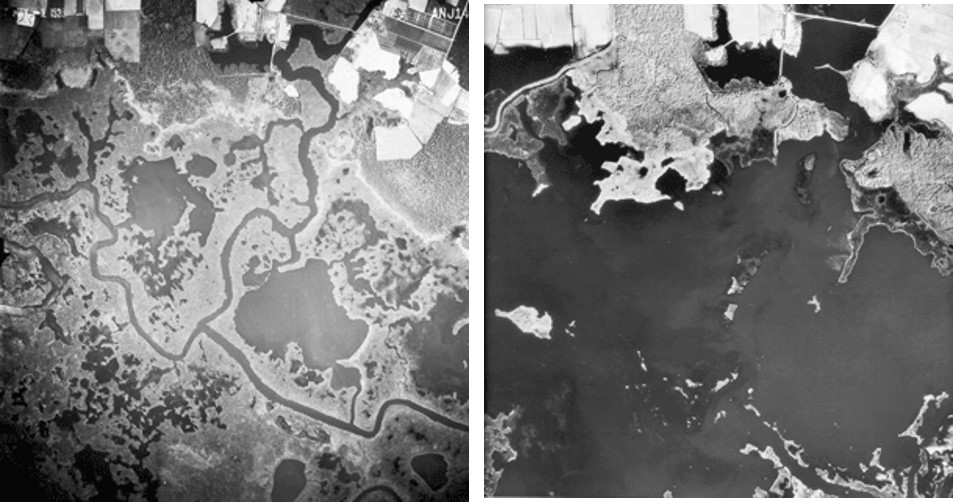 Wetland loss caused by nutria damage in Blackwater National Wildlife Refuge, Delmarva Peninsula, Chesapeake Bay. Left, normal marsh in 1939 before nutria introduction in the 1940s. Right, by 1989, over 50% of the Refuge's marshes had been converted to open water due to the destructive feeding habits of nutria. Photos courtesy of USFWS.
Wetland loss caused by nutria damage in Blackwater National Wildlife Refuge, Delmarva Peninsula, Chesapeake Bay. Left, normal marsh in 1939 before nutria introduction in the 1940s. Right, by 1989, over 50% of the Refuge's marshes had been converted to open water due to the destructive feeding habits of nutria. Photos courtesy of USFWS.
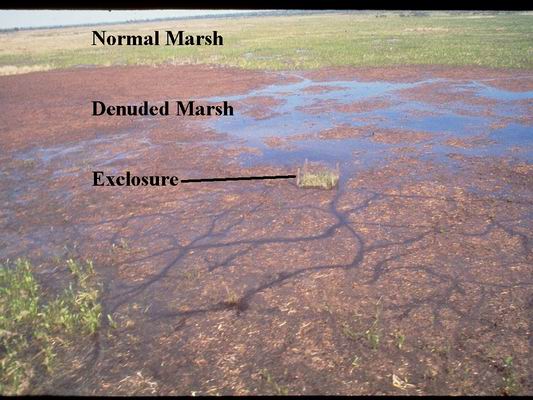 An exclosure experiment in a Louisiana marsh demonstrating the severe ecological damages caused by nutria herbivory in wetland habitats. Photo courtesy of Louisiana Dept. of Wildlife and Fisheries.
An exclosure experiment in a Louisiana marsh demonstrating the severe ecological damages caused by nutria herbivory in wetland habitats. Photo courtesy of Louisiana Dept. of Wildlife and Fisheries.
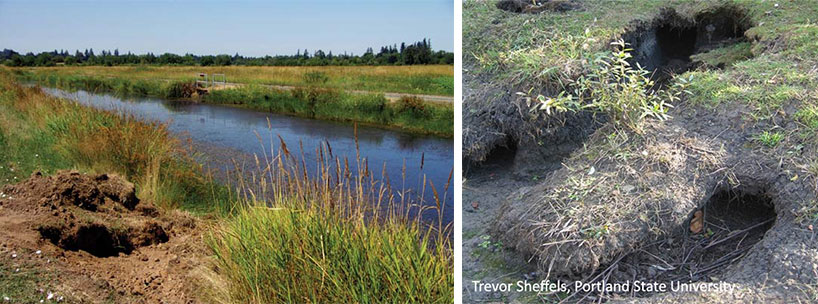 Nutria burrowing causes extensive damage to water infrastructure, banks, and levees, and creates a hazard for people, livestock, and machine operators. Potential levee and dike failures due to nutria burrowing have serious implications for flood protection, water delivery, and agricultural irrigation in California. Left, nutria burrow in Tualatin National Wildlife Refuge in Oregon. Photo courtesy of USFWS. Right, extensive burrowing damage by nutria in Oregon. Photo courtesy of Trevor Sheffels, PSU.
Nutria burrowing causes extensive damage to water infrastructure, banks, and levees, and creates a hazard for people, livestock, and machine operators. Potential levee and dike failures due to nutria burrowing have serious implications for flood protection, water delivery, and agricultural irrigation in California. Left, nutria burrow in Tualatin National Wildlife Refuge in Oregon. Photo courtesy of USFWS. Right, extensive burrowing damage by nutria in Oregon. Photo courtesy of Trevor Sheffels, PSU.
Discovery in California
Nutria were originally introduced to the U.S. (Elizabeth Lake, California) for the fur-trade in 1899, but failed to reproduce. Subsequent introductions were successful, as records indicate nutria were present in the Central Valley and South Coast of California in the 1940s and 50s, but nutria were later declared eradicated from the state in the 1970s. In 2017, a reproducing population of nutria was discovered in California’s San Joaquin Valley. The timeline of significant nutria detections and CDFW's response are detailed below.
- March 2017: the first nutria (a pregnant female) is incidentally taken in a private wetland in Gustine (Merced County).
- Summer 2017: CDFW conducts surveys in the area to evaluate the extent of the potential infestation; 19 additional nutria are taken in the managed wetlands of the Grasslands Ecological Area.
- February 2018: CDFW institutes an Incident Command System (ICS), partially redirecting staff to implement eradication efforts. The ICS operates in collaboration with USFWS, CDFA, DWR, and through supplemental contracts with USDA-Wildlife Services.
- September 2018: the first reproducing population of nutria within the legal Sacramento-San Joaquin Delta boundary is discovered south of Lathrop (San Joaquin County).
- May 2019: an individual, dispersing nutria is detected on camera near Rough and Ready Island, approximately 16 miles north of the nearest known population and previous detections.
- July 2019: the state legislature provides CDFW with funding and positions to create a Nutria Eradication Program. With additional grant funding from the USFWS, Wildlife Conservation Board, and Delta Conservancy, CDFW transitions out of the ICS and begins full-scale operations with fully-dedicated staff and resources.
- October 2022: a family group of nutria is detected on lower Sherman Island (Sacramento County), with 61 nutria subsequently removed between then and August 2025.
- May 2023: nutria are detected near southern Grizzly Island, with a total of 1,028 animals subsequently taken from the broader Suisun Marsh area (Solano County) as of December 8, 2025.
- 2024: nutria are detected up the San Joaquin River in Fresno County, to Friant Dam and above Millerton Lake near new Auberry.
- August 2024: Two adult nutria are taken from Dutch Slough (Contra Costa County), across the Sacramento County line and south of Sherman Island. As of April 8, 2025, a total of 20 adult and juvenile nutria had been taken from the area.
- February 2025: Nutria scat-detector dogs detect nutria presence (confirmed by tracks) near Lemoore Station (Kings County). In May 2025, one subadult male is taken in Kings County, near Schilling.
- November 2025: Nutria scat-detector dogs detect nutria scat in Lookout Slough (Solano County).
As of December 8, 2025, a total of 7,444 nutria have been taken in California, with additional animals confirmed present, across Merced, Stanislaus, Fresno, Solano, San Joaquin, Fresno, Mariposa, Sacramento, Madera, Contra Costa, Kings, and Tuolumne counties. Confirmed detections of nutria and locations of take in California can be viewed in the nutria detection map (PDF). The interactive map, below, can be used to view the locations and densities of nutria taken by year(s). See the summary of the nutria eradication efforts in California (PDF), which includes the distribution of nutria taken by county, by year.
Nutria Taken in California, by Year (as of 12/8/25)
| |
2017 |
2018 |
2019 |
2020 |
2021 |
2022 |
2023 |
2024 |
2025 |
Total Across Years |
| Total # nutria taken |
21 |
349 |
492 |
1,239 |
701 |
580 |
677 |
1,353 |
2,032 |
7,444 |
| Total (unique) 40-acre cells with nutria taken |
7 |
57 |
73 |
157 |
145 |
112 |
120 |
214 |
241 |
769 |
| Average # nutria taken per cell |
3.0 |
6.1 |
6.7 |
7.9 |
4.8 |
5.2 |
5.6 |
6.3 |
8.4 |
9.7 |
Nutria Taken in California, by County (as of 12/8/25)
| Merced |
Fresno |
Solano |
Stanislaus |
Madera |
San Joaquin |
Sacramento |
Mariposa |
Contra Costa |
Kings |
Total |
| 3,086 |
1,973 |
1,028 |
1,005 |
129 |
110 |
61 |
27 |
24 |
1 |
7,444 |
Eradication Effort
CDFW is collaborating with other agencies and local partners to develop the most effective strategy for eradicating nutria from California. As depicted in the "Invasion Curve" figure below, invasive species infestations typically experience a lag phase, while population size and area infested are relatively small, successful eradication is most feasible, and control efforts are most cost-efficient. As time progresses, the population size, area infested, and costs required for control increase exponentially, and the probability of successful eradication is lost. Conceptually, (1) represents where we believe the current extent of the nutria population is in California; eradication is feasible with rapid response; (2) represents the nutria population in the Chesapeake Bay (Delmarva Peninsula) prior to implementation of the Chesapeake Bay Nutria Eradication Project (CBNEP). The CBNEP strategically removed over 14,000 nutria from 2000-2015 and has not detected a nutria since early 2015. (3) represents the nutria population in Louisiana, where population control costs up to $2 million dollars each year for bounty harvests alone.
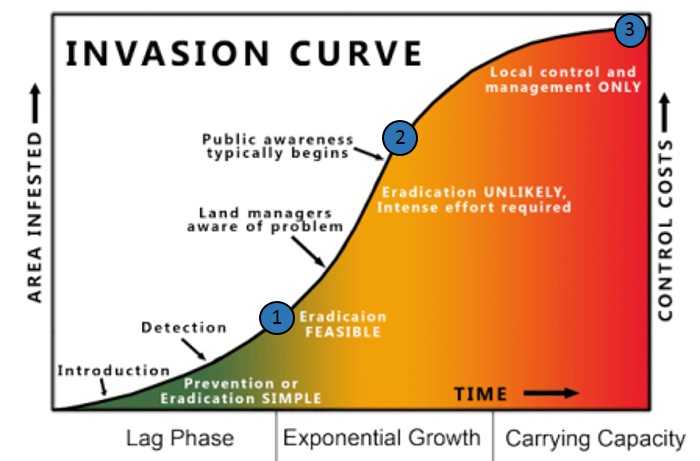
Currently, there is a small window of opportunity to successfully eradicate the population of nutria from California. As time progresses, the population size and geographic area of infestation are increasing, along with the effort, resources, and funds required for successful eradication. Over time, the probability of successful eradication decreases, and California would be left to manage and mitigate the devastating impacts of nutria on wetlands, agriculture, and water conveyance/flood control infrastructure.
The interagency Nutria Response Team includes representatives from CDFW, the California Departments of Food and Agriculture, Parks and Recreation, and Water Resources, the U.S. Department of Agriculture, the U.S. Fish and Wildlife Service and local county agricultural commissioner offices. The team is currently preparing an eradication plan, the first stage of which is determining the full extent of the infestation. Assistance from local landowners and the public throughout the Central Valley, Sacramento-San Joaquin Delta, and beyond is critical to successfully delineating the population.
Take by Landowners/Hunters
In California, nutria are classified as a nongame mammal. Fish and Game Code §4152 specifies property owners or their agents (who possess written permission from the owner or tenant) may take nutria at any time by any legal means to address damage to crops or property. Restrictions apply to the use of traps and types of traps. Nutria are a Restricted Species in California under the California Code of Regulations, Title 14, Section 671, and cannot be imported, transported, or possessed live in the state of California.
Given their very similar appearances, particularly in overlapping size classes, citizens should take extra caution to distinguish nutria from other aquatic mammals (PDF); the majority of nutria reports received by CDFW have been muskrats, as have been some "nutria" featured in the media. Any nutria taken on private or public land should be reported to CDFW as soon as possible for purposes of delineating the extent of the infestation. At minimum, CDFW needs photos to confirm identification; preferably, CDFW needs the carcass to determine sex, age, and reproductive status.
Nutria Identification
Nutria are large, semi-aquatic rodents that reach up to 2.5 feet in body length, 12- to 18-inch tail length and +20 pounds in weight. Nutria strongly resemble native beaver and muskrat, but are distinguished by their round, sparsely haired tails and white whiskers (see CDFW's nutria ID guide (PDF) or Delta Stewardship Council's nutria pocket guide (PDF)). Both nutria and muskrat often have white muzzles, but muskrats have dark whiskers, nearly triangular (laterally compressed) tails and reach a maximum size of five pounds. Beavers have wide, flattened tails and dark whiskers and reach up to 60 pounds. Other small mammals can sometimes be mistaken for nutria if seen briefly or in low light conditions, including river otters and mink.
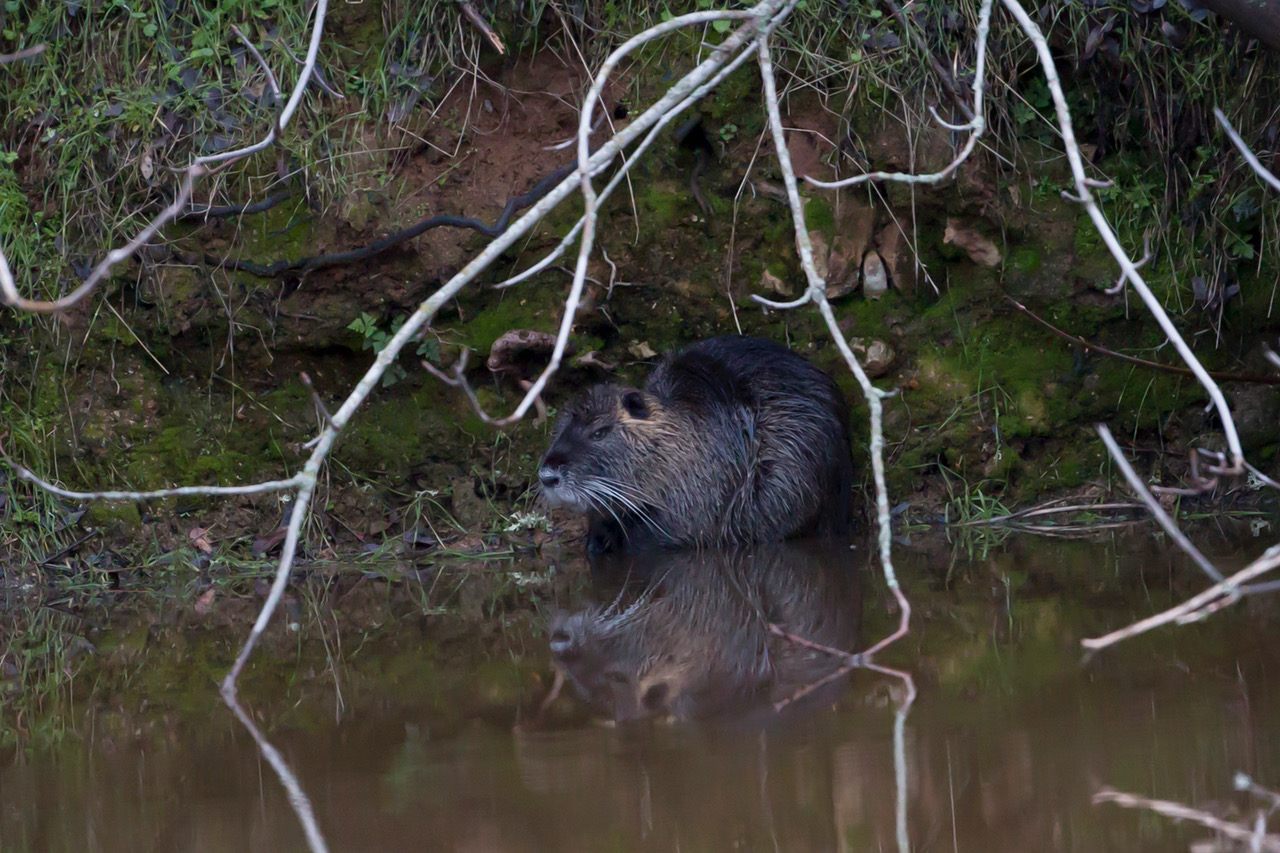 Adult nutria discovered in a private pond in Tuolumne County, east of Don Pedro Reservoir. Though muskrats may have a white muzzle, both muskrats and beaver have dark whiskers. Nutria have characteristic white whiskers, and most often have conspicuous, darks ears with light-colored fur underneath, as seen in this image. Photo courtesy of Peggy Sells.
Adult nutria discovered in a private pond in Tuolumne County, east of Don Pedro Reservoir. Though muskrats may have a white muzzle, both muskrats and beaver have dark whiskers. Nutria have characteristic white whiskers, and most often have conspicuous, darks ears with light-colored fur underneath, as seen in this image. Photo courtesy of Peggy Sells.
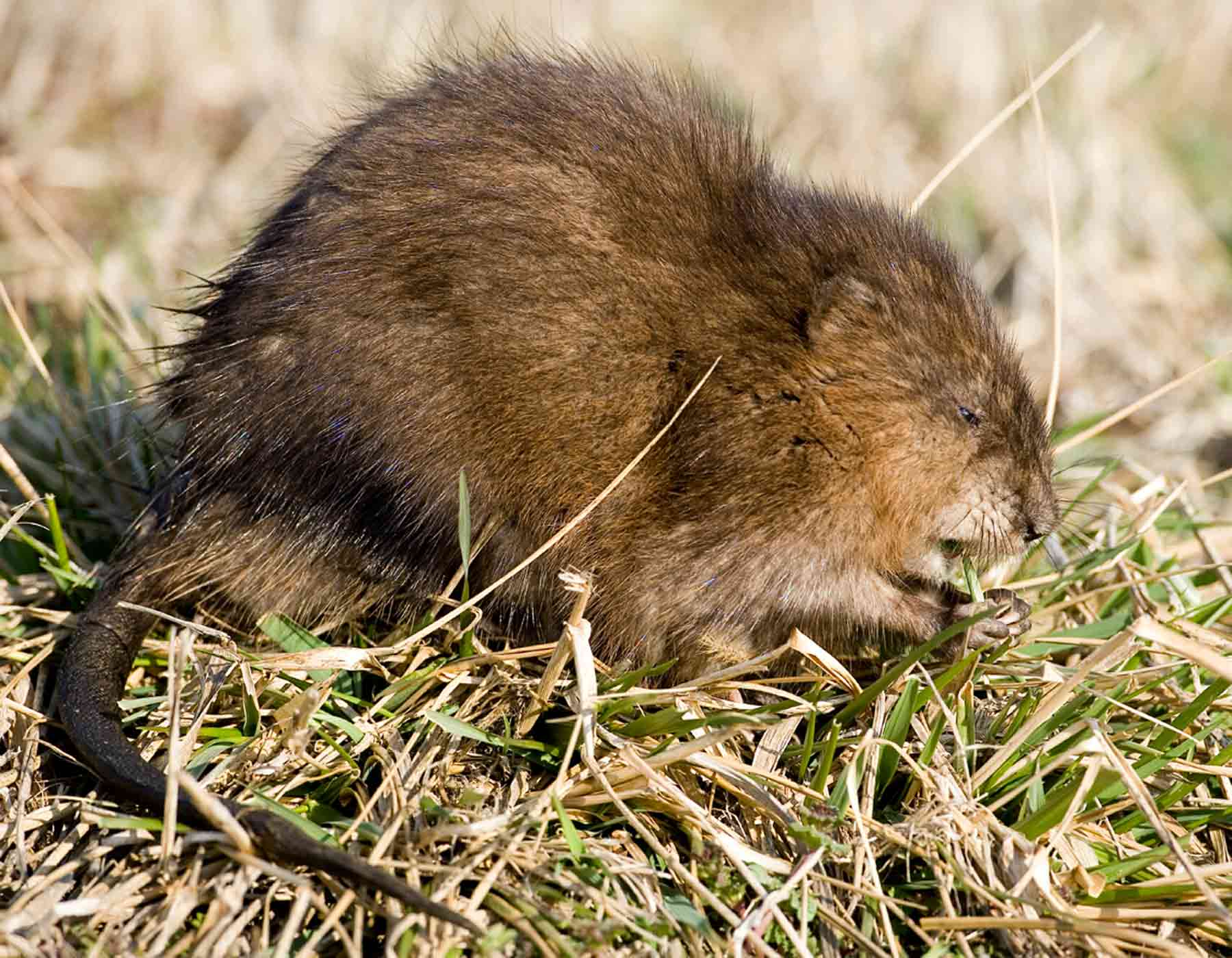
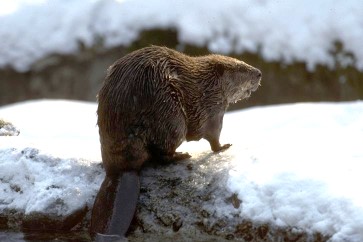
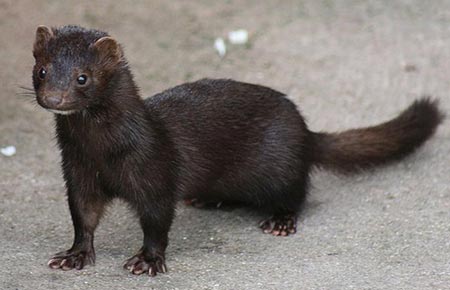 California has several aquatic mammals that occur in the same habitats and may be confused with nutria.
California has several aquatic mammals that occur in the same habitats and may be confused with nutria.
Left: Muskrat—note the nearly triangular tail and dark whiskers that distinguish muskrats from small nutria. Photo courtesy of Missouri Dept. of Conservation.
Center: American beaver—note the broad, flat tail that, along with dark whiskers, distinguishes small beavers from nutria. CDFW photo.
Right: American mink—note the fully furred tail, dark whiskers, and weasel-like body form. Photo courtesy of Alaska Dept. of Fish and Game.
 Left: Juvenile river otters, pictured here in a cattail marsh, may also be mistaken for nutria. Note the long body and thick, fully-furred tail. CDFW photo.
Left: Juvenile river otters, pictured here in a cattail marsh, may also be mistaken for nutria. Note the long body and thick, fully-furred tail. CDFW photo.
Right: Adult river otter. Photo courtesy of National Park Service.
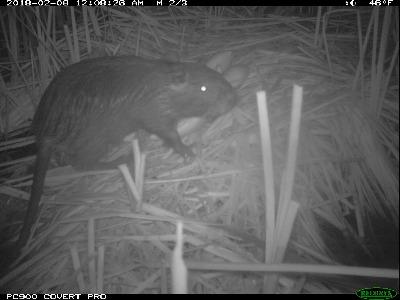
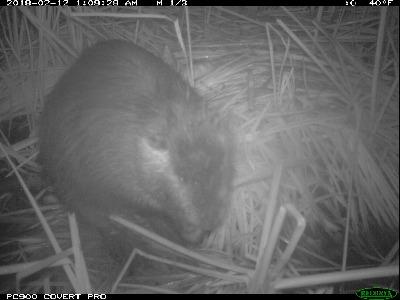 Nutria often have a dark undercoat, with lighter-colored guard hairs. Their dark, conspicuous ears, with lighter fur underneath, are helpful in distinguishing nutria from other aquatic mammals when their round tail is not clearly visible. CDFW photos.
Nutria often have a dark undercoat, with lighter-colored guard hairs. Their dark, conspicuous ears, with lighter fur underneath, are helpful in distinguishing nutria from other aquatic mammals when their round tail is not clearly visible. CDFW photos.
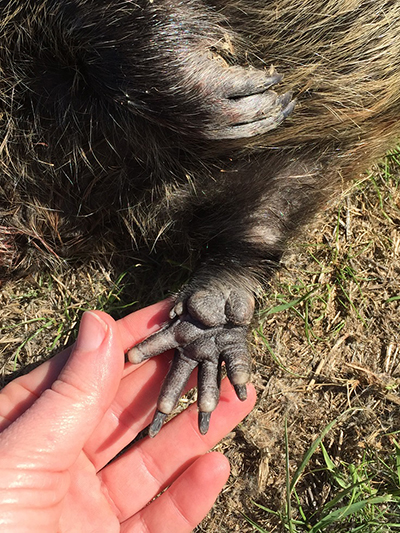
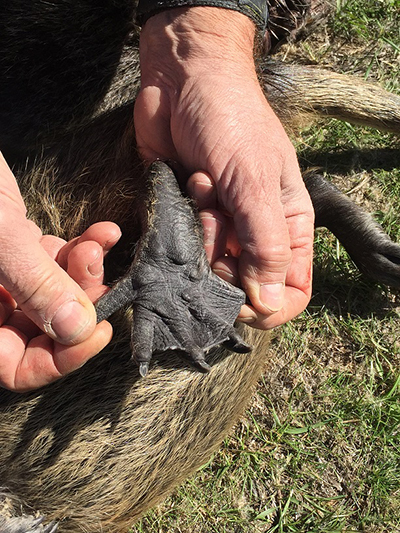 Left: Nutria front foot, showing the four toes visible in tracks and the barely visible fifth, residual toe on the inner, lower area of the foot.
Left: Nutria front foot, showing the four toes visible in tracks and the barely visible fifth, residual toe on the inner, lower area of the foot.
Right: Nutria hind foot, showing the webbing between the inner four toes and outer, fifth toe free from webbing. CDFW photos.
Habitat
Nutria can be found anywhere in or near freshwater or estuaries. Thus far, they have been found in cattail and tule marshes, ponds, canals, sloughs, and rivers. All currently known locations are upstream of the Sacramento-San Joaquin Delta, which provides a vast amount of ideal and interconnected habitat for nutria.
Look for nutria and signs of nutria presence in wetlands, canals, rivers, and creeks, along levees and riparian areas, in flooded agricultural fields adjacent to waterways, and in the transition zone between wetland and terrestrial habitat.
Sign
Because nutria are wasteful feeders, signs of presence typically include cut, emergent vegetation (e.g. cattails and bulrushes), with only the basal portions eaten and the cut stems left floating, or grazed tops of new growth. Nutria create runs between feeding sites and burrows. Nutria often pile cuttings to create feeding/grooming platforms. Nutria construct burrows with entrances typically below the water line, though changing water levels may reveal openings. Nutria tracks have four visible front toes and, on their hind feet, webbing between four of five toes. Tracks are often accompanied by narrow tail drags.
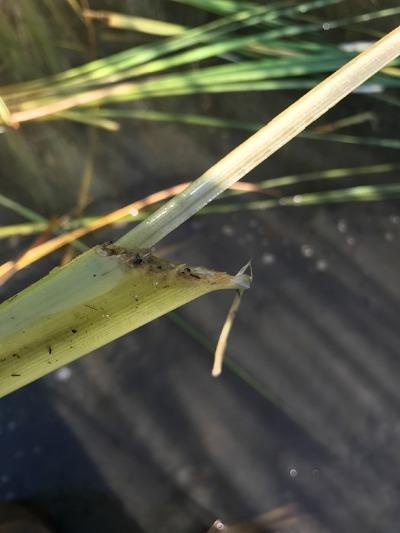
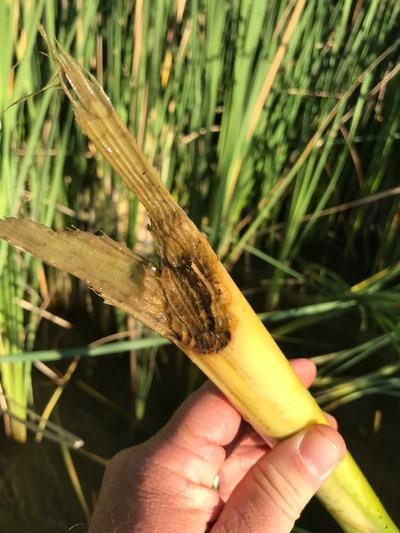 Nutria cuttings have a 45 degree angle bite and often have a residual strip attached to the stem. CDFW photos.
Nutria cuttings have a 45 degree angle bite and often have a residual strip attached to the stem. CDFW photos.
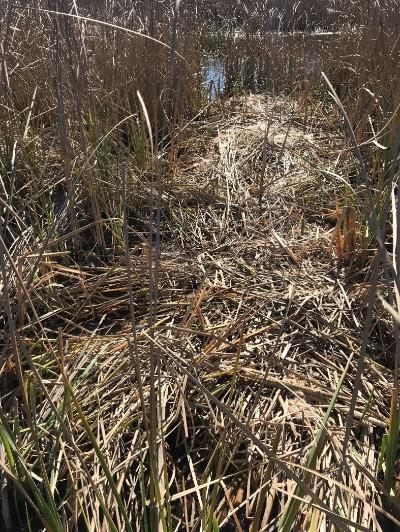
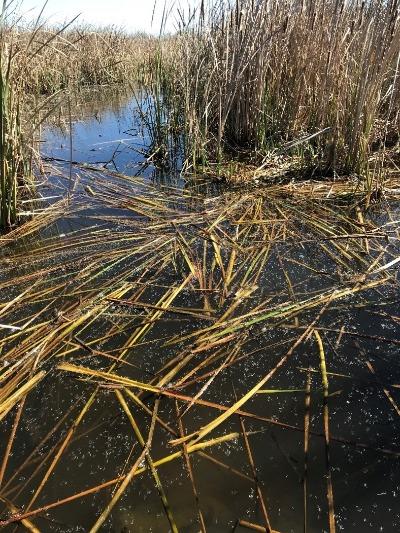
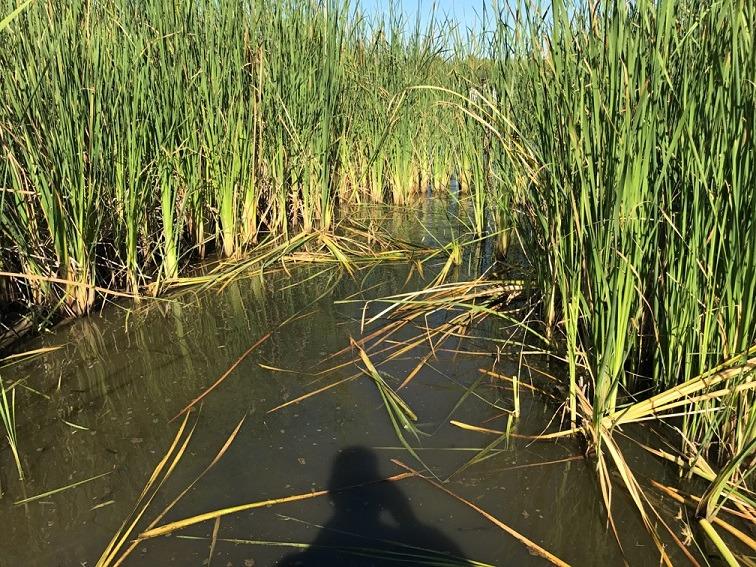 Top left: Nutria often pile their vegetation cuttings into feeding/grooming beds.
Top left: Nutria often pile their vegetation cuttings into feeding/grooming beds.
Top right: Cattails cut by nutria and left lying in the marsh, a characteristic sign of nutria presence.
Bottom: A vegetation clearing or "eat out" with cuttings floating throughout the area, characteristic signs of nutria herbivory damage. CDFW photos.
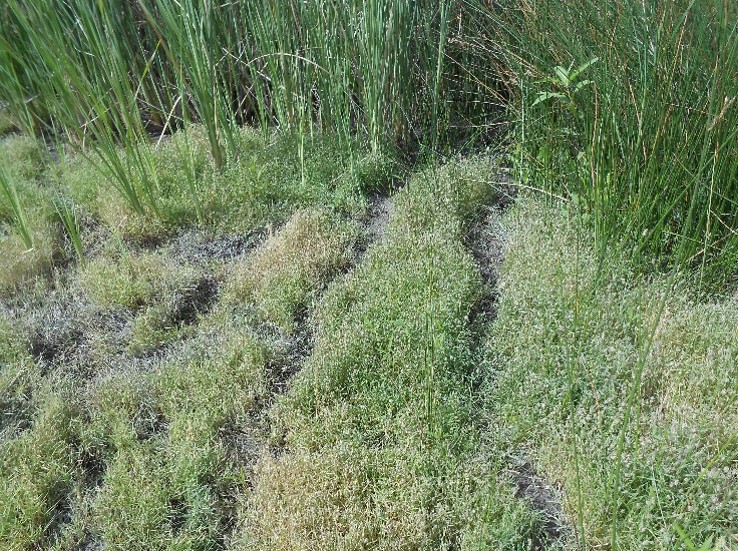 Nutria create "runs" in the vegetation between feeding areas and near entry/exit points along the water's edge. CDFW photo.
Nutria create "runs" in the vegetation between feeding areas and near entry/exit points along the water's edge. CDFW photo.
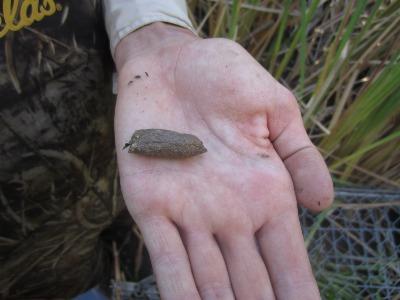
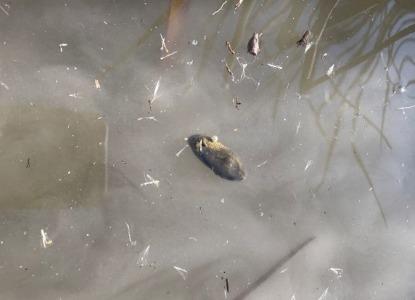 Nutria scat is distinctly grooved and floats on the water's surface. CDFW photos.
Nutria scat is distinctly grooved and floats on the water's surface. CDFW photos.
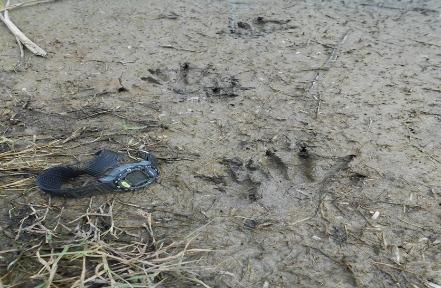
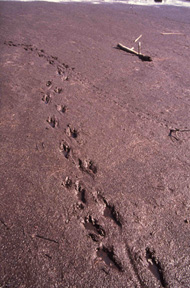 Left: Closeup of nutria tracks showing webbing between 4 of 5 toes on the hind foot. CDFW photo.
Left: Closeup of nutria tracks showing webbing between 4 of 5 toes on the hind foot. CDFW photo.
Right: Nutria tracks and tail drag. Photo courtesy of USDA.
Outreach Materials and Resources